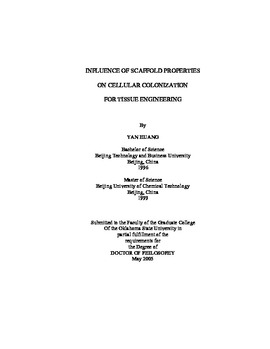| dc.contributor.advisor | Madihally, Sundararajan V. | |
| dc.contributor.author | Huang, Yan | |
| dc.date.accessioned | 2013-11-26T08:31:39Z | |
| dc.date.available | 2013-11-26T08:31:39Z | |
| dc.date.issued | 2005-05 | |
| dc.identifier.uri | https://hdl.handle.net/11244/7156 | |
| dc.description.abstract | Scope and Method of Study: Scaffolds properties play crucial roles in regulating the cell-matrix interaction. To understand how the scaffolds architecture (i.e. pore structures), the presence of cell-binding domain and stiffness affect cell colonization within the scaffolds, 2D and 3D chitosan and poly (lactide-co-glycolide) (PLGA)-chitosan scaffolds without cell-binding domain were synthesized through controlled rate freezing and lyophilization. Cytoskeletal organization, morphology, and proliferation of Human umbilical vein endothelial cells (HUVECs) and mouse embryonic fibroblasts (MEFs) seeded on 2D, 3D chitosan, PLGA-chitosan scaffolds were characterized. Next, gelatin which contains cell-binding domain was blended with chitosan to investigate cell adhesion characteristics through receptor-mediated binding under static and shear conditions. Murine embryonic stem (mES) cells were used as model to study the differentiation process under the influence of substratum and medium components (i.e. cytokines). | |
| dc.description.abstract | Findings and Conclusions: Both HUVECs and MEFs showed circular morphology with reduced spreading area on 2D scaffolds while increased spreading and connected cell organization within 3D chitosan matrices. 2D and 3D emulsified chitosan and PLGA-chitosan scaffolds did not support spreading of HUVECs and MEFs. In gelatin-chitosan membranes, effect of gelatin was dominant; actin and focal adhesion kinase (FAK) distribution were comparable to gelatin in static culture. However, at higher shear stresses, presence of chitosan inhibited shear-induced increase in cell spreading and weakened cell adhesive strength. More composition of gelatin in the 3D chitosan scaffolds inhibited cell spreading within the porous structures. Similarly, the presence of chitosan in the membranes did not support mES attachment. These results support the hypothesis that the presence of cellbinding domain in the materials assumes the most important roles in regulating cell adhesion on 2D matrix whereas microarchitecture and stiffness are more important in 3D scaffolds on influencing cellular colonization. | |
| dc.format | application/pdf | |
| dc.language | en_US | |
| dc.rights | Copyright is held by the author who has granted the Oklahoma State University Library the non-exclusive right to share this material in its institutional repository. Contact Digital Library Services at lib-dls@okstate.edu or 405-744-9161 for the permission policy on the use, reproduction or distribution of this material. | |
| dc.title | Influence of scaffold properties on cellular colonization for tissue engineering | |
| dc.contributor.committeeMember | Lewis, Randy S. | |
| dc.contributor.committeeMember | Fan, Guoliang | |
| dc.contributor.committeeMember | Arjmandi, Bahram H. | |
| osu.filename | Huang_okstate_0664D_1376.pdf | |
| osu.accesstype | Open Access | |
| dc.type.genre | Dissertation | |
| dc.type.material | Text | |
| thesis.degree.discipline | Chemical Engineering | |
| thesis.degree.grantor | Oklahoma State University | |
